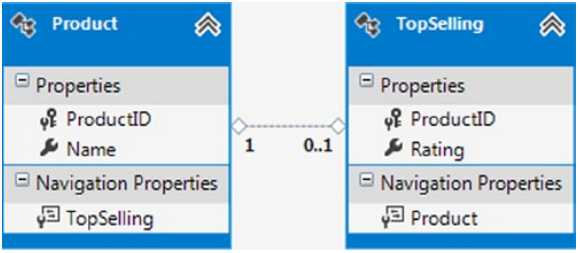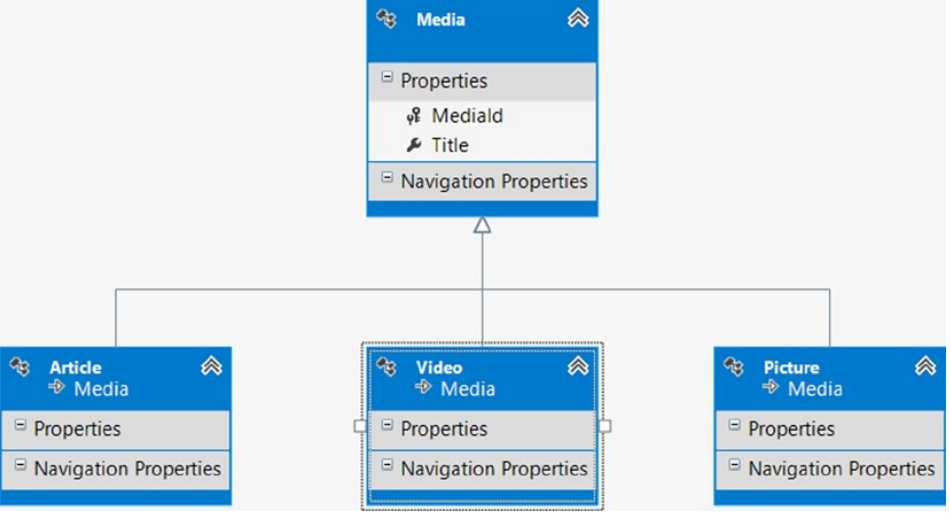标签:
翻译的初衷以及为什么选择《Entity Framework 6 Recipes》来学习,请看本系列开篇
问题
你想使用左外连接来合并两个实体的属性。
解决方案
假设你有如图3-11所示的模型。

图3-11 一个包含Product和TopSelling的模型
畅销产品有一个与之关联的TopSelling实体。当然,不是所有的产品都是畅销产品。这就是为什么关系为零或者1。当一个产品为畅销产品时,与之关联的topSelling实体包含一个用户评级。你想查找和呈现所有的产品,和与之关联的热销榜单实体,即使产品不是一个畅销产品。如果产品没有相关联的热销榜单,我们就简单地用0来设置用户评级。 在数据库中,这叫做左外连接。
代码清单3-22演示了三种略有不同的方法来解决这个问题。
代码清单3-22. 两个实体间的左外连接
1 using (var context = new EFRecipesEntities()) 2 { 3 // 删除之前的测试数据 4 context.Database.ExecuteSqlCommand("delete from chapter3.topselling"); 5 context.Database.ExecuteSqlCommand("delete from chapter3.product"); 6 // 添加新的测试数据 7 // 注意p1没有与之关联的TopSelling实体 8 var p1 = new Product { Name = "Trailrunner Backpack" }; 9 var p2 = new Product 10 { 11 Name = "Green River Tent", 12 TopSelling = new TopSelling { Rating = 3 } 13 }; 14 var p3 = new Product 15 { 16 Name = "Prairie Home Dutch Oven", 17 TopSelling = new TopSelling { Rating = 4 } 18 }; 19 var p4 = new Product 20 { 21 Name = "QuickFire Fire Starter", 22 TopSelling = new TopSelling { Rating = 2 } 23 }; 24 context.Products.Add(p1); 25 context.Products.Add(p2); 26 context.Products.Add(p3); 27 context.Products.Add(p4); 28 context.SaveChanges(); 29 } 30 31 using (var context = new EFRecipesEntities()) 32 { 33 var products = from p in context.Products 34 orderby p.TopSelling.Rating descending 35 select p; 36 Console.WriteLine("All products, including those without ratings"); 37 38 foreach (var product in products) 39 { 40 Console.WriteLine("\t{0} [rating: {1}]", product.Name, 41 product.TopSelling == null ? "0" 42 : product.TopSelling.Rating.ToString()); 43 } 44 } 45 46 using (var context = new EFRecipesEntities()) 47 { 48 var products = from p in context.Products 49 join t in context.TopSellings on 50 //注意,我们如何将结果集投影到另一个名为‘g‘的序列中,以及应用DefaultIfEmpty方法 51 p.ProductID equals t.ProductID into g 52 from tps in g.DefaultIfEmpty() 53 orderby tps.Rating descending 54 select new 55 { 56 Name = p.Name, 57 Rating = tps.Rating == null ? 0 : tps.Rating 58 }; 59 60 Console.WriteLine("\nAll products, including those without ratings"); 61 foreach (var product in products) 62 { 63 Console.WriteLine("\t{0} [rating: {1}]", product.Name, 64 product.Rating.ToString()); 65 } 66 } 67 68 using (var context = new EFRecipesEntities()) 69 { 70 var esql = @"select value p from products as p 71 order by case when p.TopSelling is null then 0 72 else p.TopSelling.Rating end desc"; 73 var products = ((IObjectContextAdapter)context).ObjectContext.CreateQuery<Product>(esql); 74 Console.WriteLine("\nAll products, including those without ratings"); 75 foreach (var product in products) 76 { 77 Console.WriteLine("\t{0} [rating: {1}]", product.Name, 78 product.TopSelling == null ? "0" 79 : product.TopSelling.Rating.ToString()); 80 } 81 } 82 83 Console.WriteLine("\nPress <enter> to continue..."); 84 Console.ReadLine(); 85 }
代码清单3-22的输出如下:
Top selling products sorted by rating Prairie Home Dutch Oven [rating: 4] Green River Tent [rating: 3] QuickFire Fire Starter [rating: 2] Trailrunner Backpack [rating: 0]Top selling products sorted by rating Prairie Home Dutch Oven [rating: 4] Green River Tent [rating: 3] QuickFire Fire Starter [rating: 2] Trailrunner Backpack [rating: 0]Top selling products sorted by rating Prairie Home Dutch Oven [rating: 4] Green River Tent [rating: 3] QuickFire Fire Starter [rating: 2] Trailrunner Backpack [rating: 0]
原理
在代码清单3-22中,我们展示了三种不的方法来处理这个问题。第一种方法最简单。因为实体框架会为关联的实体自动创建join连接,它是基于模型创建时被创建的导航属性。这两个实体的关联为1-0...1,这意味着,实体框架在自动生成SQL查询时,会在这两个实体间包含一个左外连接。当product实体被实例化时,任何与之关联的topsellers也会被实例化。导航属性TopSeller也会被设置为相关联的实体,如是不存在TopSellers就为null。如果给定的产品不存在与之关联的TopSeller实体(也就是说,它没有被评为畅销产品)。我们会简单的分配一个0值给产品的评级。
在某些情况下,你想连接的两个实体间可能没有一个关系(对实例而言,是一个导航属性)。这样的话,你可以显示连接实体。把结果集投影到一个匿名类型。我们之所以需要将结果集投影到匿名类型,是因为没有关联的两个实体间没有导航属性。否则我们不可以引用相关联的实体。
在第二段查询的代码中演示了这种方法。通过键ProductId连接两个实体,然后把结果集投影到一个新的名为‘g‘的序列中。随后,我们在g上应用DefaultIfEmpty()方法,当g为空时,它会用null值填充。毫无疑问,当SQL语句被产生时,两个实体间将会包含一个左外连接。我们通过一个orderby从句,让结果集根据rating排序。最后,我们将结果投影到一个匿名类型。
在第三中方法中,我产展示了在Entity SQL中,如何更明确地使用左外连接。在查询中嵌入一个Entity SQL语句。
问题
当你使用TPH继承映射时,你想通过派生类来给结果集排序。
解决方案
假设你有如图3-12所示的模型。

图3-12 使用TPH继承映射的模型,包含三个派生类弄型
这个模型使用TPH继承映射,它是实体框架一个特性,TPH创建这样的一个继承结构,父类和子类都源至数据库中的同一张表。
在这个示例中,Media实体有一个属性名为Mediatype,它被用作TPH结构中的鉴别属性。MediaType的值决定着数据库表中的行被映射到哪个派生类型(Article,Picture,或者Video)。鉴别列的值为1时代表Article类型,为2时代表Video类型,为3时代表Picture类型。因为这个属性被用来决定派生类型,它将不在Media实体中显示。
我们在代码清单3-23中使用Code-First,创建了实体类,为了保持示例的简单性,我们只创建了空的派生子对象。因为我只是为了演示在查询中通过派生类型来排序。
代码清单3-23. 父类和子类实体类型
1 public class Media 2 { 3 public int MediaId { get; set; } 4 public string Title { get; set; } 5 } 6 public class Article : Media 7 { 8 } 9 public class Picture : Media 10 { 11 } 12 public class Video : Media 13 { 14 }
接下来,在代码清单3-24中,我们创建了数据库上下文对象,它是我们凭借实体框架中Code-First方法的入口。注意,如何在OnModelCreating方法中,使用FluentAPI(换句话说就是将扩展方法链接起来创建一个操作)。显式映射鉴别列,MediaType,到子类型。
代码清单3-24 DbContext对象
1 public class EFRecipesEntities : DbContext 2 { 3 public EFRecipesEntities() 4 : base("ConnectionString") {} 5 6 public DbSet<Media> Media { get; set; } 7 8 protected override void OnModelCreating(DbModelBuilder modelBuilder) 9 { 10 modelBuilder.Entity<Media>().ToTable("Chapter3.Media"); 11 12 13 modelBuilder.Entity<Media>().Map<Article>(x => x.Requires("MediaType").HasValue(1)); 14 modelBuilder.Entity<Media>().Map<Picture>(x => x.Requires("MediaType").HasValue(2)); 15 modelBuilder.Entity<Media>().Map<Video>(x => x.Requires("MediaType").HasValue(3)); 16 17 base.OnModelCreating(modelBuilder); 18 } 19 }
随着Code-First的构件被创建,我们将查询模型中所有的media,并通过派生类型:Article,Video,和Picture进行排序。如代码清单3-25所示。
代码清单3-25.在TPH继承映射中通过类型排序
1 using (var context = new EFRecipesEntities()) 2 { 3 //删除之前的测试数据 4 context.Database.ExecuteSqlCommand("delete from chapter3.Media"); 5 // 添加新的测试数据 6 context.Media.Add(new Article 7 { 8 Title = "Woodworkers‘ Favorite Tools" 9 }); 10 context.Media.Add(new Article 11 { 12 Title = "Building a Cigar Chair" 13 }); 14 context.Media.Add(new Video 15 { 16 Title = "Upholstering the Cigar Chair" 17 }); 18 context.Media.Add(new Video 19 { 20 Title = "Applying Finish to the Cigar Chair" 21 }); 22 context.Media.Add(new Picture 23 { 24 Title = "Photos of My Cigar Chair" 25 }); 26 context.Media.Add(new Video 27 { 28 Title = "Tour of My Woodworking Shop" 29 }); 30 context.SaveChanges(); 31 } 32 33 using (var context = new EFRecipesEntities()) 34 { 35 var allMedium = from m in context.Media 36 let mediumtype = m is Article 37 ? 1 38 : m is Video ? 2 : 3 39 orderby mediumtype 40 select m; 41 Console.WriteLine("All Medium sorted by type...\n"); 42 foreach (var medium in allMedium) 43 { 44 Console.WriteLine("Title: {0} [{1}]", medium.Title, medium.GetType().Name); 45 } 46 } 47 48 Console.WriteLine("\nPress <enter> to continue..."); 49 Console.ReadLine(); 50 }
代码清单3-25的输出如下:
1 All Media sorted by type... 2 Title: Woodworkers‘ Favorite Tools [Article] 3 Title: Building a Cigar Chair [Article] 4 Title: Upholstering the Cigar Chair [Video] 5 Title: Applying Finish to the Cigar Chair [Video] 6 Title: Tour of My Woodworking Shop [Video] 7 Title: Photos of My Cigar Chair [Picture]
原理
当我们使用TPH继承映射时,我们凭借表中一列来区别给定的行代表的派生类型。这一列,通常被称作鉴别列。它不能被映射到实体中的属性。因为我们没有属性包含鉴别值 ,所以,需要创建一个变量来保存鉴别值以便我们进行排序。为了实现这个目的,我们使用了LINQ中的let从句。它创建了一个mediatype变量。我们通过条件语句来将整型的鉴别值分配给这个变量。Article类型的分配1,Video类型的分配2,其它类型的分配3。这里的其它类型其实就是Picture类型,因为没有别的派生类型了。
实体框架交流QQ群: 458326058,欢迎有兴趣的朋友加入一起交流
谢谢大家的持续关注,我的博客地址:http://www.cnblogs.com/VolcanoCloud/
《Entity Framework 6 Recipes》中文翻译系列 (16) -----第三章 查询之左连接和在TPH中通过派生类排序
标签:
原文地址:http://www.cnblogs.com/VolcanoCloud/p/4512954.html